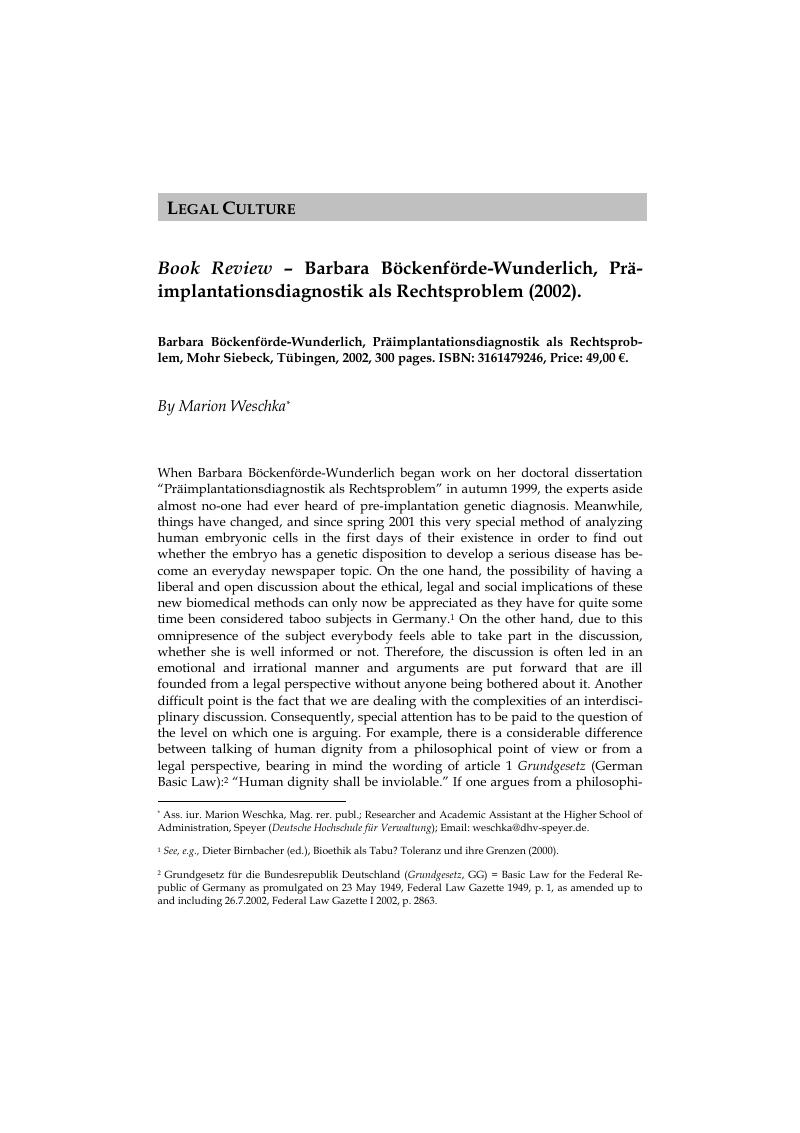No CrossRef data available.
Published online by Cambridge University Press: 06 March 2019

1 See, e.g., Dieter Birnbacher (ed.), Bioethik als Tabu? Toleranz und ihre Grenzen (2000).Google Scholar
2 Grundgesetz für die Bundesrepublik Deutschland (Grundgesetz, GG) = Basic Law for the Federal Republic of Germany as promulgated on 23 May 1949, Federal Law Gazette 1949, p. 1, as amended up to and including 26.7.2002, Federal Law Gazette I 2002, p. 2863.Google Scholar
3 Gesetz zum Schutz von Embryonen (Embryonenschutzgesetz – ESchG) as promulgated on 13 December 1990, Federal Law Gazette I, p. 2746.Google Scholar
4 Article 119 Bundesverfassung der Schweizerischen Eidgenossenschaft as promulgated on 18 April 1999 as amended up to and including 15 July 2003, available at: http://www.admin.ch/ch/d/sr/1/101.de.pdf. See especially Art. 119 sec. 2 lit. a and c.Google Scholar
5 A totipotent cell is a cell that has the potential to develop into an embryo. It contains the same genetic material as the embryo, therefore the splitting of a totipotent cell from the embryo means cloning the embryo.Google Scholar
6 It is possible that Article 119 sec. 2 lit. c could allow for the use of PGD, as this clause explicitly provides for the use of IVF where the danger of transmitting a serious disease cannot be avoided in any other way.Google Scholar
7 Article 5 sec. 3 Bundesgesetz über die medizinisch unterstützte Fortpflanzung (Fortpflanzungsmedizingesetz, FmedG) as promulgated on 18 December 1998, available on the internet: http://www.admin.ch/ch/d/as/2000/3055.pdf Google Scholar
8 Fortpflanzungsmedizingesetz as promulgated on 14 May 1992, Federal Law Gazette 275/1992. See especially § 9 sec. 1 and § 2 sec. 2.Google Scholar
9 Harris, John, The Value of Life, London/New York 1985, p. 19, cited after Böckenförde-Wunderlich, p. 56.Google Scholar
10 Committee of Inquiry into Human Fertilization and Embryology (Warnock Commission) named after the chair woman Mary Warnock.Google Scholar
12 Article 3 sec. 1 and 3 Human Fertilization and Embryology Act 1990 (c. 37).Google Scholar
13 Schedule 2 Sec. 3 (2) (e) Human Fertilization and Embryology Act: “A licence under this paragraph cannot authorize any activity unless it appears to the Authority to be necessary or desirable for the purpose of […] (e) developing methods for detecting the presence of gene or chromosome abnormalities in embryos before implantation.”Google Scholar
14 Schedule 2, section 1, subsection 1 (d) Human Fertilization and Embryology Act 1990 (c. 37).Google Scholar
15 Deech, Ruth, Chairman of the HFEA, cited after Böckenförde-Wunderlich, p. 77.Google Scholar
16 Admittedly, Böckenförde-Wunderlich is more skeptical with regard to this point.Google Scholar
17 BVerfGE 33,125.Google Scholar
18 Article 74 sec. 1 no. 26 Grundgesetz.Google Scholar
19 This is prohibited by § 4 sec. 1 no. 2 Embryonenschutzgesetz.Google Scholar
20 See Böckenförde-Wunderlich, p. 139, ann. 132.Google Scholar
21 So-called „Dürig-Formel“ named after Günter Dürig, Der Grundsatz von der Menschenwürde, AöR 81 (1956), p. 117, 127.Google Scholar
22 BVerfGE 1, 97, 104.Google Scholar
23 The actual wording is: „Die Würde des Menschen ist unantastbar“ The literal translation would be: „The dignity of the human being is inviolable“Google Scholar
24 Strafgesetzbuch (StGB) = Criminal Code as promulgated on 13 November 1998, Federal Law Gazette I, p. 3322 as amended up to and including 22 August 2002, Federal Gazette I, p. 3390.Google Scholar
25 BVerfGE 39, 1; 88, 203.Google Scholar
26 BVerfGE 88, 203, 278.Google Scholar